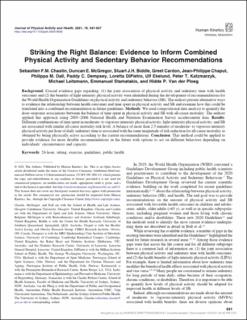| dc.contributor.author | Chastin, Sebastien F.M. | |
| dc.contributor.author | McGregor, Duncan E. | |
| dc.contributor.author | Biddle, Stuart J.H. | |
| dc.contributor.author | Cardon, Greet | |
| dc.contributor.author | Chaput, Jean-Philippe | |
| dc.contributor.author | Dall, Philippa M. | |
| dc.contributor.author | Dempsey, Paddy C. | |
| dc.contributor.author | DiPietro, Loretta | |
| dc.contributor.author | Ekelund, Ulf | |
| dc.contributor.author | Katzmarzyk, Peter T. | |
| dc.contributor.author | Leitzmann, Michael | |
| dc.contributor.author | Stamatakis, Emmanuel | |
| dc.contributor.author | van der Ploeg, Hidde P. | |
| dc.date.accessioned | 2022-08-01T06:29:56Z | |
| dc.date.available | 2022-08-01T06:29:56Z | |
| dc.date.created | 2021-06-16T08:38:47Z | |
| dc.date.issued | 2021 | |
| dc.identifier.citation | Journal of Physical Activity and Health. 2021, 18 (6), 631-637. | |
| dc.identifier.issn | 1543-3080 | |
| dc.identifier.uri | https://hdl.handle.net/11250/3009362 | |
| dc.description.abstract | Background: Crucial evidence gaps regarding: (1) the joint association of physical activity and sedentary time with health outcomes and (2) the benefits of light-intensity physical activity were identified during the development of recommendations for the World Health Organization Guidelines on physical activity and sedentary behavior (SB). The authors present alternative ways to evidence the relationship between health outcomes and time spent in physical activity and SB and examine how this could be translated into a combined recommendation in future guidelines. Methods: We used compositional data analysis to quantify the dose–response associations between the balance of time spent in physical activity and SB with all-cause mortality. The authors applied this approach using 2005–2006 National Health and Nutrition Examination Survey accelerometer data. Results: Different combinations of time spent in moderate- to vigorous-intensity physical activity, light-intensity physical activity, and SB are associated with similar all-cause mortality risk level. A balance of more than 2.5 minutes of moderate- to vigorous-intensity physical activity per hour of daily sedentary time is associated with the same magnitude of risk reduction for all-cause mortality as obtained by being physically active according to the current recommendations. Conclusion: This method could be applied to provide evidence for more flexible recommendations in the future with options to act on different behaviors depending on individuals’ circumstances and capacity. | |
| dc.language.iso | eng | |
| dc.title | Striking the right balance: Evidence to inform combined physical activity and sedentary behavior recommendations | |
| dc.type | Peer reviewed | |
| dc.type | Journal article | |
| dc.description.version | publishedVersion | |
| dc.source.pagenumber | 631-637 | |
| dc.source.volume | 18 | |
| dc.source.journal | Journal of Physical Activity and Health | |
| dc.source.issue | 6 | |
| dc.identifier.doi | 10.1123/jpah.2020-0635 | |
| dc.identifier.cristin | 1916017 | |
| cristin.ispublished | true | |
| cristin.fulltext | original | |
| cristin.qualitycode | 1 | |
